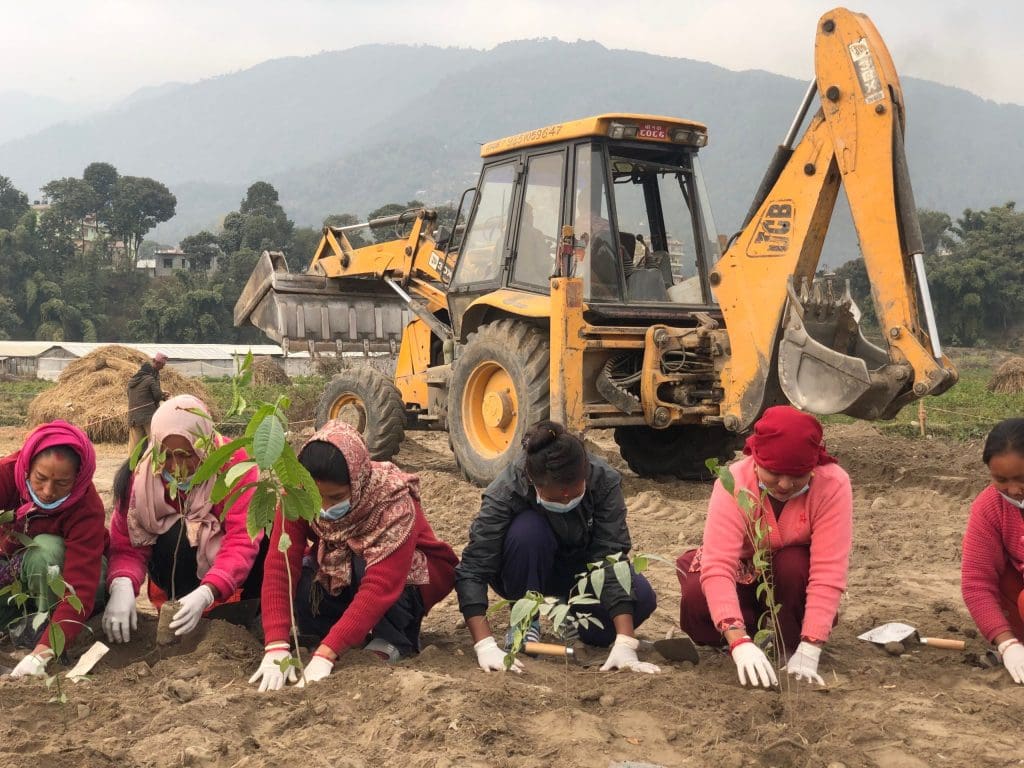The Sacred Rivers Climate Project (SRCP) is helping stop climate change while fighting some of the most pressing existential threats to human health and dignity: loss of habitat, biodiversity, and air, water, and plastic pollution, and the education, empowerment, and employment of women.
CEO Joseph Kelly explains how mycoremediation works and why it’s so important as a socially-focused drawdown solution: “I saw many climate projects doing good work on atmospheric CO2 reduction, drawdown, and sequestration, but ignoring the plight of communities in Asia, South America, and Africa who are suffering the brunt of the impact of climate change. We decided we would enroll those communities in the solution while also addressing their everyday concerns about improving their lives. Since rivers are the planet’s circulatory system it made sense to focus planting forests on their riverbanks.”
SRCP’s parent company, HiveMind, was founded in 2008 by senior students of visionary mycologist Paul Stamets. Their goal was to find a natural way to increase the uptake of atmospheric CO2 and sequestration in soil from trees and plants. They researched hundreds of species of ectomycorrhizal and endomycorrhizal mycelium associated with long-term sequestration of carbon in soils in boreal forests and discovered two dozen species that were viable.
The students conducted trials on a dozen green roofs in Chicago. The results showed that it was possible to sequester significant amounts of CO2 as carbon in soils on small sites ranging from 500 to 1000 square meters. Best of all, this type of CO2 capture and sequestration didn’t rely on fossil fuels or massive inputs of materials like many other drawdown technologies.
With the signing of the Paris Agreement, HiveMind’s business grew as they built partnerships with two of the world’s top 10 carbon emitters, Shell Oil and Cummins Diesel. Dozens more global energy, construction, and utility companies are in advanced talks to adopt the technology.
By 2019, many countries and companies realized they were far short of their Paris Agreement commitments, and turned to the carbon market to make up the shortfall. A handful of agencies, like Gold Standard and Verra, rigorously verify technologies that increase atmospheric CO2 uptake and sequestration so that buyers can be confident they are getting what they pay for.
HiveMind began the process of verification for its mycelium technology in 2019 and expects the certification will be completed in 2020. This certification will allow them to develop 1,000 thousand-acre sites, planting trees inoculated with their mycelium to sell large batches of Verified Carbon Units (VCUs).
During visits to Asia, South America, and Africa, Kelly and his team realized that many communities were already fighting the effects of climate change while also struggling with myriad challenges. Some of these issues were addressed by civic groups, non-profits, and INGOs, but most for-profit companies remained on the sidelines.
On a trip to Nepal in August, 2019, Kelly saw a community of Gurung people displaced by the massive 2015 earthquake and squatting in tents by the Bagmati River. It was there he realized the people who were often viewed as victims, spectators, or even part of the problem were actually the key to the solution.
“No one wants to leave their home, village, or community or live in a wasteland without clean air or water, education or employment. No one consciously wants to degrade or destroy the environment. Everyone wants a better life for themselves, their kids and grandchildren. Talking with members of this community, I was impressed by their resilience, work ethic, and phenomenal plant and climate knowledge. In particular, the women who were in charge of planting the staple crop of rice were fantastic resources of exactly the types of plant knowledge we need.”
And so, the SRCP was conceived. This separate division of HiveMind will meld climate change action with the United Nation’s sustainable development goals. HiveMind agreed to license its mycelium technology to SRCP and develop protocols for riparian zones and rice fields. A mycoremediation component using oyster mushrooms in burlap sacks was developed to clean up the Bagmati River and a plastic cleanup program was launched in partnership with Nepali civic groups.
Kelly and his team returned to Nepal in October 2019 to plant the pilot site, employing women from the Gurung community as workers and advisors. Using a forestry protocol developed by Japanese arborist Miyawaki, they planted a mini-forest of indigenous species that will grow to six feet within two years and twelve feet within four years. That forest will contain all the biodiversity of a naturally grown forest and thirty times the biodiversity of a typical tree plantation.
The response to the pilot project has been phenomenal. Dozens of other site coordinators are asking for planting opportunities, including two UNESCO world heritage sites: Patan Museum and Pashupatinath Temple. The Sacred Rivers Climate Project is currently seeking investors to scale up. For more information, contact their team, and learn more on the SRCP website.
Source: CleanTechnica









